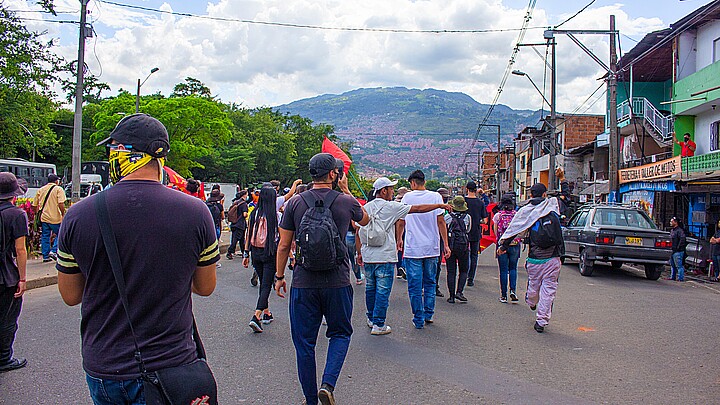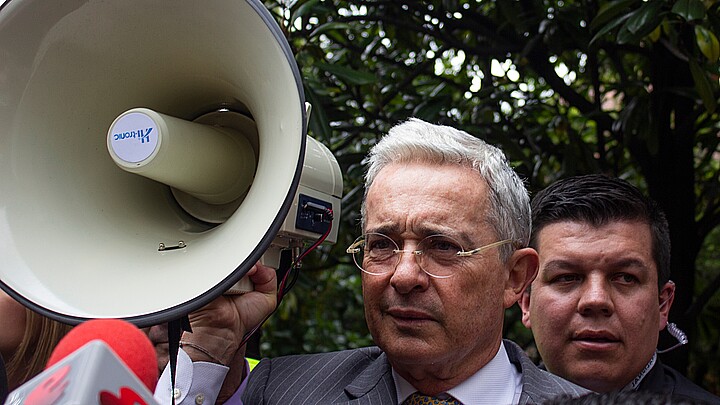Business
U.S. second largest importer of illegal gold mining from South American criminal enterprises
In mid-January, in the northern region of the country, the Ecuadorian National Police dealt a blow to Los Lobos by seizing 1,072 bags of gold from trucks en route to a processing plant

March 8, 2024 9:21am
Updated: March 8, 2024 9:21am
Criminal groups engaged in drug trafficking in Ecuador are expanding their operations into illegal gold mining to help facilitate their money laundering operations, according to local reports and crime sleuths.
In mid-January, in the northern region of the country, the Ecuadorian National Police dealt a blow to Los Lobos by seizing 1,072 bags of gold from trucks en route to a processing plant. The seized shipment was valued at $2 million.
Links to Mexican drug cartels
Los Lobos, a criminal organization linked to Mexico's Jalisco New Generation Cartel (CJNG), which claims responsibility for the assassination of former presidential candidate Fernando Villavicencio, has expanded its activities from drug trafficking, assassination, and extortion to illegal gold mining in one of Ecuador's most significant mining areas in the south of the country: the canton of Camilo Ponce Enríquez in the province of Azuay.
The CJNG is involved in multiple drug trafficking activities, with a focus on extensive methamphetamine manufacturing and the importation of precursor chemicals from China and India. It maintains vital distribution hubs in Los Angeles, New York, Chicago, Houston, and Atlanta, with a growing presence along the Southwest border, and activities in smaller towns throughout the nation.
In parallel with the growing presence of drug cartels, Ecuador has seen a surge in gold export figures since 2019 that is significantly disproportionate to its production.
Ecuador's illegal mining export networks
Illegal mining hotspots in Ecuador along the northern border with Colombia and Peru are making it easier for criminal enterprises and independent illegal miners to transport illegal goods, according to authorities.
Illegal miners are good at finding minerals in faraway and hard-to-reach places like natural parks. They set up informal operations and routes to move the gold they find and supplies they need. This includes smuggling explosives, mercury, illegal gold, and weapons, as well as illegal migration of miners.
Overall, the mix of illegal gold networks from Peru and Colombia with those in Ecuador fuels illegal mining and gold trading in the country.
COSEPE, the nation's Public Security and State Council, declared illegal mining a threat to state security after evidence revealed its connection to other crimes including drug trafficking, money laundering, arms trafficking, and human trafficking.
From Jan. 9-Feb. 14, security forces carried out more than 96,000 operations, and detained nearly 8,000 criminals, the president of Ecuador said via X, adding that its “commitment to safety remains steadfast,” according to reports by SOUTHCOM magazine Dialogo Américas.
The main destinations for gold exports from Ecuador are Switzerland ($257M), United States ($238M), United Arab Emirates ($45.2M), Italy ($19.8M), and India ($15.8M), according to the Observatory for Economic Complexity, a data visualization website for international trade data.
An appealing market for U.S. companies
Ecuador is an appealing market for U.S. companies because Ecuadorians are familiar with U.S. brands and see them as high-quality, according to the U.S. Department of Trade. Ecuador's use of the U.S. dollar is also an appealing enticement for many businesses and investors located in the United States.
Ecuador also boasts some of the most accessible and profitable natural resources in Latin America.
Gold, silver, and copper deposits are easily accessible and of high quality. Petroleum deposits are conventional and spread across the eastern provinces of Ecuador, with some limited offshore production.
The metal from its main mining provinces — Zamora Chinchipe (bordering Peru), El Oro, and Esmeraldas (bordering Colombia) — also often ends up in the United States.
In a 2015 Insight Crime report titled, “Following the Trail of Illegal Gold from Latin America to the United States,” the online investigative publication reported that such remote areas are where mineral exploitation has been conducted informally for decades, and are the origin of products received by Republic Metals Corporation and NTR Metals, recipients of Colombian mineral exports.
In 2018, NTR along with two other companies, Elemetal LLC, pleaded guilty to federal charges of money laundering tied to the precious metals industry in violation of the Bank Secrecy Act, according to a report published by the U.S. Attorney for the Southern District of Florida.
“Elemetal purchased and refined billions of dollars of gold from countries around the world, including from Central America, South America, the Caribbean and Europe,” the report says. “The international gold trade was a common method for laundering illegally mined gold, narcotics and other criminal proceeds. Criminals frequently trade illegal gold through illicit shell companies using false or incomplete documents. The gold is often smuggled through third-party countries and then sold to refineries in the United States, in an effort to hide the true source of the gold from foreign and United States law enforcement.”
Crime surrounding gold exploitation has also become rampant across South America.
In Colombia, these links extend to drug trafficking and the guerrilla group Revolutionary Armed Forces of Colombia (FARC). The Colombian government acknowledges that 87% of metal-producing units operate outside the law and that this activity has displaced cocaine trafficking in some regions seized by armed groups, such as Chocó, Caquetá, and Amazonas.
The ‘dirty gold’ trade route between South America and the United States
According to an investigation by Ojo Público in 2023, the other metals also reach the United States from Bolivia from northern La Paz and the Beni and Pando jungle (bordering Brazil).
In a 2015 OjoPúblico report titled Dirty Gold: “Tracing the trace of the London Bullion Market,” the publication revealed that the southern neighbor sent an estimated six tons of metal annually between 2003 and 2011. Some of that metal isn't real gold, the publication charges.
“During the journalistic investigation in this country, we identified that one of the largest recipients of mineral of dubious origin is Atomic Gold, an almost unknown company located in Miami (which is not a member of the London Bullion Market), along with NTR Metals, Kaloti and Republic Metals Corporation,” the report says.
“They received even the gold that was declared as metal waste by Bolivian exporters. OjoPublico also knew that one family of La Paz, formed by Ronald Saavedra Orosco, her sister and nephews, operated the largest shipments of mineral to the US: 14 tons in the last four years.”
The Insight Crime report also corroborated that a single family from La Paz (Ronald Saavedra Orosco, his sister, and nephews), managed the largest mineral shipments to the United States: 14 tons in the last four years.










